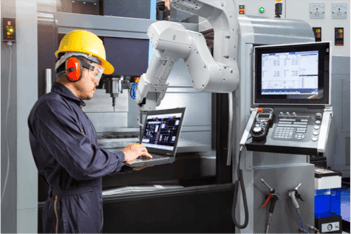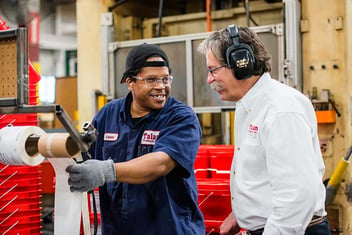7 Signs It’s Time to Consider Automation for Improved Manufacturing Performance
 Today, many manufacturing tasks have the ability to be automated, leaving valuable employees to spend their time on something more fulfilling.
Today, many manufacturing tasks have the ability to be automated, leaving valuable employees to spend their time on something more fulfilling.
According to our 2019 State of Northeast Ohio Manufacturing Report, 44% of regional manufacturers increased their use of automation over the last year. Automation provides small- to medium-sized manufacturers the opportunity to compete with larger companies, while improving productivity, lowering production costs, and improving workplace safety.
But how do you know if automation is right for your plant? To make the right choice, consider these 7 factors.
1. Process Safety or Environmental Concerns
Are the operations your employees perform a safety risk for employees?
If so, automation may decrease the likelihood of employee injury, while increasing plant performance and production. According to the National Safety Council, 104 million production days were lost due to work-related injuries in one year—but properly designed automation systems with safe guards in place limit injury.
2. Need for Increased Capacity
Operations on certain tasks cannot efficiently and economically scale using manual labor.
In fact, manual labor can complicate your company’s progress by decreasing product consistency and quality. By incorporating automation, your company can more efficiently meet a greater demand.
3. Quality Improvement
Your company will be at risk if you do not consistently produce high-quality products. Inconsistent output results in scrap and rework expenses that set the company behind, leading to a negative impact on profits and customer satisfaction. Properly designed and maintained automation systems yield a more consistent product.
4. Labor Shortage
Manufacturers are facing a skilled labor shortage and a graying workforce (the majority of employees are nearing retirement age).
Across Northeast Ohio, 86% of manufacturers surveyed reported that it is difficult or somewhat difficult to attract qualified applicants, while another 60% say an ability to attract new skilled workers is hindering growth.
Those same manufacturers surveyed above also mention that they are using automation to augment employee labor versus replacing humans. This gives current employees development opportunities while reducing the need to hire as many entry level employees. The use of automation also helps those small and mid-sized manufacturers maintain production schedules, ensuring they meet deadlines as the talent search continues.
5. Competitive Pressures
Manufacturers constantly face pressure to stay ahead of their competitors while producing quality products and keeping costs low. The introduction of automation, combined with a new product or process, allows manufacturers to stay ahead of the curve while offsetting increasing labor and material costs.
6. Equipment Obsolescence
Old, outdated machinery is prone to breaking down. This results in costly downtime with expensive repairs needing parts that may be difficult to find. These occurrences cause havoc to your production schedule.
New machines decrease these occurrences, providing production certainty and making deliveries on time.
7. New Product Introduction
A new product line opens the doors to an unsaturated market and lucrative revenue streams. However, it’s often difficult—if not impossible—to adapt legacy machines to produce new offerings.
A new, automated machine designed specifically for your application can fast track your company’s foray into new markets.


